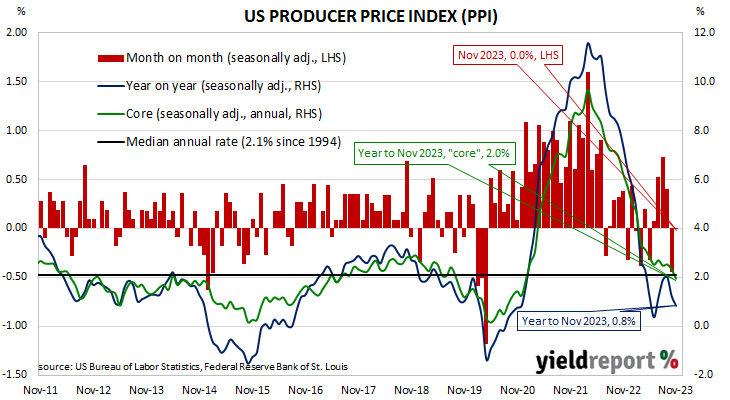Summary: US producer price index (PPI) flat in November, less than expected; annual rate slows to 0.8%; “core” PPI also flat; ANZ: shows normalisation in supply-chain price pressures, firms’ pricing power; US Treasury yields plunge; 2024 rate-cut expectations harden; goods prices, services prices both flat.
Around the end of 2018, the annual inflation rate of the US producer price index (PPI) began a downtrend which continued through 2019. Months in which producer prices increased suggested the trend may have been coming to an end, only for it to continue, culminating in a plunge in April 2020. Figures returned to “normal” towards the end of that year but then moved well above the long-term average in 2021 and 2022.
The latest figures published by the Bureau of Labor Statistics indicate producer prices remained flat after seasonal adjustments in November. The result was less than the 0.1% increase which had been generally expected but more than October’s -0.4% after revisions. On a 12-month basis, the rate of producer price inflation after seasonal adjustments and revisions slowed from October’s revised figure of 1.2% to 0.8%.
Producer prices excluding foods and energy, or “core” PPI, were also flat after seasonal adjustments. The result was less than the expected 0.2% increase but in line with October’s unchanged reading. The annual growth rate slowed from 2.3% to 2.0%.
“As has been the case in recent months, the data show a normalisation in supply-chain price pressures and reduced firms’ pricing power,” said ANZ senior economist Blair Chapman.
The figures were released on the same day as the latest FOMC policy decision and US Treasury bond yields plunged on the day. By the close of business, the 2-year Treasury yield had shed 28bps to 4.45%, the 10-year yield had lost 17bps to 4.03% while the 30-year yield finished 13bps lower at 4.18%.
In terms of US Fed policy, expectations of a lower federal funds rate in the next 12 months hardened significantly. At the close of business, contracts implied the effective federal funds rate would average 5.33% in January, in line with the current spot rate, 5.245% in March and 4.92% in May. December 2024 contracts implied 4.025%, 130bps less than the current rate.
The BLS stated the indices for final demand goods and final demand services both remained flat.
The producer price index is a measure of prices received by producers for domestically produced goods, services and construction. It is put together in a fashion similar to the consumer price index (CPI) except it measures prices received from the producer’s perspective rather than from the perspective of a retailer or a consumer. It is another one of the various measures of inflation tracked by the US Fed, along with core personal consumption expenditure (PCE) price data.


